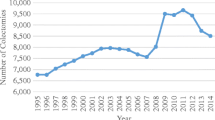Abstract
Background
Risk factors for complications differ between laparoscopic (LC) and open colectomy (OC) patients, given the selection bias between these groups. How risk factors for these outcomes differ between inpatient and post-discharge phases of care requires further study.
Methods
A retrospective cohort study (2005–2010) using NSQIP data was performed comparing OC and LC patients. Multivariable logistic regression was used to compare covariates associated with mortality and overall complication rates both before and after hospital discharge.
Results
Patients in the LC cohort were younger (64.2 vs. 62.5 years; P < 0.0001) with a lower incidence of comorbidities. OC was associated with a higher incidence of mortality compared to LC among inpatients (3.3 vs. 0.61 %, P < 0.0001) and following discharge (0.88 vs. 0.29 %, P < 0.0001). OC also demonstrated a higher incidence of overall complication rates for both inpatients (22.32 vs. 9.36 %, P < 0.0001) and following discharge (8.83 vs. 7.24 %, P < 0.0001). Risk factors (P < 0.05) for mortality following LC included age and emergency procedures for inpatients; pre-operative SIRS was associated with mortality occurring after discharge. For the OC cohort, risk for mortality was increased with smoking and contaminated/dirty wounds for inpatients; pre-operative weight loss was associated with death following discharge. Factors associated with increased risk of morbidity following LC included smoking history for inpatients and pre-operative steroid therapy following discharge. Following OC, morbidity was strongly associated with ASA scores for inpatients; pre-operative steroid therapy was a risk factor following discharge. Obesity was strongly associated with non-mortal complications in both cohorts following discharge.
Conclusions
(1) LC is associated with a lower incidence of post-operative mortality and complications. (2) Risk factors associated with adverse post-operative outcomes change during the post-operative period; surveillance for these outcomes should be tailored by operative technique and phase of post-operative care (3) Obesity is an underappreciated risk for complications following discharge for both LC and OC.
Similar content being viewed by others
References
Owen RM, Perez SD, Lytle N, Patel A, Davis SS, Lin E, Sweeney JF (2013) Impact of operative duration on postoperative pulmonary complications in laparoscopic versus open colectomy. Surg Endosc 27:3555–3563
Aytac E, Stocchi L, Remzi FH, Kiran RP (2012) Is laparoscopic surgery for recurrent Crohn’s disease beneficial in patients with previous primary resection through midline laparotomy? A case-matched study. Surg Endosc 26:3552–3556
Delaney CP, Pokala N, Senagore AJ, Casillas S, Kiran RP, Brady KM, Fazio VW (2005) Is laparoscopic colectomy applicable to patients with body mass index > 30? A case-matched comparative study with open colectomy. Dis Colon Rectum 48:975–981
Gu J, Stocchi L, Remzi FH, Kiran RP (2013) Total abdominal colectomy for severe ulcerative colitis: does the laparoscopic approach really have benefit? Surg Endosc 28(2):617–625
Bartels SA, Gardenbroek TJ, Ubbink DT, Buskens CJ, Tanis PJ, Bemelman WA (2013) Systematic review and meta-analysis of laparoscopic versus open colectomy with end ileostomy for non-toxic colitis. Br J Surg 100:726–733
Delaney CP (2008) Outcome of discharge within 24–72 h after laparoscopic colorectal surgery. Dis Colon Rectum 51:181–185
Kerwel TG, Leichtle SW, Asgeirsson T, Hendren SK, Cleary RK, Luchtefeld MA (2014) Risk factors for readmission after elective colectomy: postoperative complications are more important than patient and operative factors. Dis Colon Rectum 57:98–104
Wick EC, Shore AD, Hirose K, Ibrahim AM, Gearhart SL, Efron J, Weiner JP, Makary MA (2011) Readmission rates and cost following colorectal surgery. Dis Colon Rectum 54:1475–1479
Kim EK, Sheetz KH, Bonn J, Deroo S, Lee C, Stein I, Zarinsefat A, Cai S, Campbell DA Jr, Englesbe MJ (2014) A statewide colectomy experience: the role of full bowel preparation in preventing surgical site infection. Ann Surg 259:310–314
Wilson MZ, Hollenbeak CS, Stewart DB (2013) Laparoscopic colectomy is associated with a lower incidence of postoperative complications compared with open colectomy: a propensity score-matched cohort analysis. Colorectal Dis. doi:10.1111/codi.12537
Bilimoria KY, Bentrem DJ, Merkow RP, Nelson H, Wang E, Ko CY, Soper NJ (2008) Laparoscopic-assisted vs. open colectomy for cancer: comparison of short-term outcomes from 121 hospitals. J Gastrointest Surg 12:2001–2009
Watanabe J, Tatsumi K, Ota M, Suwa Y, Suzuki S, Watanabe A, Ishibe A, Watanabe K, Akiyama H, Ichikawa Y, Morita S, Endo I (2013) The impact of visceral obesity on surgical outcomes of laparoscopic surgery for colon cancer. Int J Colorectal Dis 29(3):343–351
Tsujinaka S, Konishi F, Kawamura YJ, Saito M, Tajima N, Tanaka O, Lefor AT (2008) Visceral obesity predicts surgical outcomes after laparoscopic colectomy for sigmoid colon cancer. Dis Colon Rectum 51:1757–1765 discussion 1765–7
Leroy J, Ananian P, Rubino F, Claudon B, Mutter D, Marescaux J (2005) The impact of obesity on technical feasibility and postoperative outcomes of laparoscopic left colectomy. Ann Surg 241:69–76
Leslie DB, Dorman RB, Anderson J, Serrot FJ, Kellogg TA, Buchwald H, Sampson BK, Slusarek BM, Ikramuddin S (2012) Routine upper gastrointestinal imaging is superior to clinical signs for detecting gastrojejunal leak after laparoscopic Roux-en-Y gastric bypass. J Am Coll Surg 214:208–213
Disclosure
Matthew Z. Wilson, Peter W. Dillon, Christopher S. Hollenbeak, PhD, and David B. Stewart, MD have no conflicts of interest or financial ties to disclose.
Author information
Authors and Affiliations
Corresponding author
Rights and permissions
About this article
Cite this article
Wilson, M.Z., Dillon, P.W., Hollenbeak, C.S. et al. How do risk factors for mortality and overall complication rates following laparoscopic and open colectomy differ between inpatient and post-discharge phases of care? A retrospective cohort study from NSQIP. Surg Endosc 28, 3392–3400 (2014). https://doi.org/10.1007/s00464-014-3609-4
Received:
Accepted:
Published:
Issue Date:
DOI: https://doi.org/10.1007/s00464-014-3609-4




